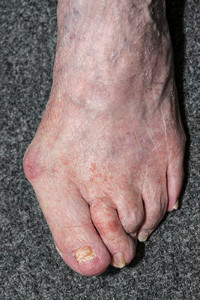
 A common sign that you may have developed a bunion is by a bump that gradually forms on the side of the big toe. Additionally, it may appear red, swollen, and can cause severe pain and discomfort. The reasons that a bunion may form can consist of wearing shoes that do not have ample room for the toes to move freely in, or from medical conditions such as arthritis, nerve damage, or due to flat feet. Additionally, genetics may also play a significant role in the development of a bunion, and research has indicated the chances may increase as the aging process occurs. Many patients that have bunions wear custom made orthotics, as this may help relieve a portion of the pressure while wearing shoes. In severe cases, if it becomes difficult to walk, surgery may be a necessary option that can permanently remove the bunion. If you feel you have developed a bunion, it is suggested that you schedule a consultation with a podiatrist who can help choose the best treatment option that is correct for you.
A common sign that you may have developed a bunion is by a bump that gradually forms on the side of the big toe. Additionally, it may appear red, swollen, and can cause severe pain and discomfort. The reasons that a bunion may form can consist of wearing shoes that do not have ample room for the toes to move freely in, or from medical conditions such as arthritis, nerve damage, or due to flat feet. Additionally, genetics may also play a significant role in the development of a bunion, and research has indicated the chances may increase as the aging process occurs. Many patients that have bunions wear custom made orthotics, as this may help relieve a portion of the pressure while wearing shoes. In severe cases, if it becomes difficult to walk, surgery may be a necessary option that can permanently remove the bunion. If you feel you have developed a bunion, it is suggested that you schedule a consultation with a podiatrist who can help choose the best treatment option that is correct for you.
If you are suffering from bunions, contact Dr. Todd Goldberg of Complete Family Foot Care Center. Our doctor can provide the care you need to keep you pain-free and on your feet.
What Is a Bunion?
A bunion is formed of swollen tissue or an enlargement of boney growth, usually located at the base joint of the toe that connects to the foot. The swelling occurs due to the bones in the big toe shifting inward, which impacts the other toes of the foot. This causes the area around the base of the big toe to become inflamed and painful.
Why Do Bunions Form?
Genetics – Susceptibility to bunions are often hereditary
Stress on the feet – Poorly fitted and uncomfortable footwear that places stress on feet, such as heels, can worsen existing bunions
How Are Bunions Diagnosed?
Doctors often perform two tests – blood tests and x-rays – when trying to diagnose bunions, especially in the early stages of development. Blood tests help determine if the foot pain is being caused by something else, such as arthritis, while x-rays provide a clear picture of your bone structure to your doctor.
How Are Bunions Treated?
If you have any questions, please feel free to contact our office located in Littlestown, PA . We offer the newest diagnostic and treatment technologies for all your foot care needs.